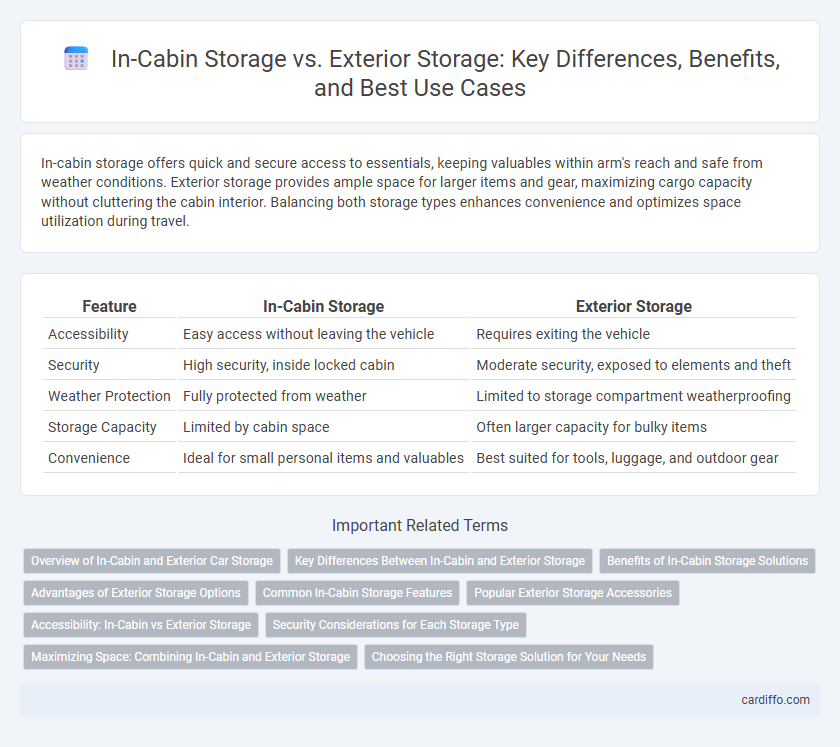In-cabin storage offers quick and secure access to essentials, keeping valuables within arm's reach and safe from weather conditions. Exterior storage provides ample space for larger items and gear, maximizing cargo capacity without cluttering the cabin interior. Balancing both storage types enhances convenience and optimizes space utilization during travel.
Table of Comparison
| Feature | In-Cabin Storage | Exterior Storage |
|---|---|---|
| Accessibility | Easy access without leaving the vehicle | Requires exiting the vehicle |
| Security | High security, inside locked cabin | Moderate security, exposed to elements and theft |
| Weather Protection | Fully protected from weather | Limited to storage compartment weatherproofing |
| Storage Capacity | Limited by cabin space | Often larger capacity for bulky items |
| Convenience | Ideal for small personal items and valuables | Best suited for tools, luggage, and outdoor gear |
Overview of In-Cabin and Exterior Car Storage
In-cabin storage offers immediate accessibility and secure compartments such as glove boxes, center consoles, and door pockets that optimize space for personal items within arm's reach. Exterior storage, including trunks, roof racks, and hitch carriers, enhances the vehicle's capacity for bulky gear and outdoor equipment while keeping the interior clutter-free. Choosing between in-cabin and exterior storage depends on the balance between convenience, security, and the type of cargo being transported.
Key Differences Between In-Cabin and Exterior Storage
In-cabin storage offers immediate accessibility and enhanced protection from weather and theft, making it ideal for valuables and frequently used items. Exterior storage provides larger capacity and better organization for bulky gear but requires weatherproofing to prevent damage. Vehicle design and security features significantly influence the effectiveness of both in-cabin and exterior storage options.
Benefits of In-Cabin Storage Solutions
In-cabin storage solutions offer immediate accessibility and enhanced organization for essential items, improving overall convenience during travel. These storage options help keep the cabin clutter-free and secure, reducing the risk of losing small personal belongings. Ergonomically designed compartments within the cabin also promote safety by minimizing distractions to the driver.
Advantages of Exterior Storage Options
Exterior storage options offer significantly greater cargo capacity compared to in-cabin storage, allowing for the transportation of bulky or dirty items without compromising passenger comfort. These storage compartments enhance vehicle organization by separating cargo from living or seating areas, reducing clutter and improving safety. Moreover, exterior storage solutions often feature weather-resistant, lockable designs, protecting belongings from theft and environmental damage.
Common In-Cabin Storage Features
Common in-cabin storage features include glove compartments, center consoles, door pockets, and seatback pockets designed for easy access and organization. These compartments are strategically placed to maximize convenience for drivers and passengers, offering secure spaces for personal items, electronics, and documents. Interior storage solutions prioritize user comfort and functionality, differentiating them from larger exterior storage options like roof racks or cargo boxes.
Popular Exterior Storage Accessories
Popular exterior storage accessories include roof racks, cargo boxes, and hitch-mounted carriers, providing versatile options for transporting gear without sacrificing in-cabin space. These accessories enhance vehicle capacity by securely holding bulky items like bicycles, kayaks, and camping equipment. Exterior storage solutions also improve cabin comfort by reducing clutter and allowing more room for passengers.
Accessibility: In-Cabin vs Exterior Storage
In-cabin storage offers superior accessibility by keeping essential items within arm's reach of passengers while traveling, reducing the need to stop or expose belongings to external elements. Exterior storage compartments, however, provide increased capacity for larger gear and luggage but require exiting the vehicle and may be less convenient in adverse weather conditions. Prioritizing in-cabin storage enhances quick access to frequently used items, whereas exterior storage excels in maximizing overall cargo volume.
Security Considerations for Each Storage Type
In-cabin storage offers enhanced security by limiting access to authorized users and protecting valuables within the locked vehicle interior, reducing theft risk. Exterior storage compartments often require robust locks and reinforced materials to prevent break-ins, as they are more exposed to potential tampering. Choosing between in-cabin and exterior storage depends on balancing accessibility and the level of security needed for specific items.
Maximizing Space: Combining In-Cabin and Exterior Storage
Maximizing space in vehicles involves strategically combining in-cabin and exterior storage solutions to enhance overall capacity and accessibility. Utilizing under-seat compartments, door pockets, and overhead bins inside the cabin complements exterior options such as roof racks, cargo boxes, and rear-mounted carriers, optimizing both convenience and load distribution. This integrated approach ensures efficient use of available space, reduces clutter, and maintains vehicle balance for improved safety and comfort.
Choosing the Right Storage Solution for Your Needs
In-cabin storage offers immediate accessibility and security for essential items, making it ideal for frequent use and valuable belongings. Exterior storage solutions provide increased capacity and are better suited for bulky or less frequently accessed equipment, optimizing overall space management. Assessing the type of items, frequency of access, and security requirements will guide the choice between in-cabin and exterior storage to maximize convenience and functionality.
in-cabin storage vs exterior storage Infographic

 cardiffo.com
cardiffo.com